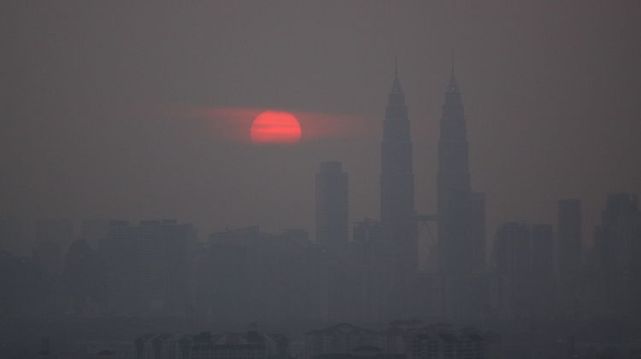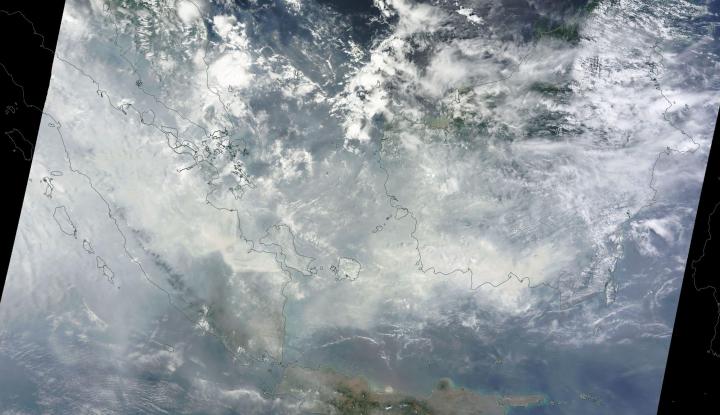“A Crime Against Humanity” — Hothouse Wildfire Smoke Sickens 500,000 As Indonesian Officials Plan For Mass Evacuations
26
October, 2015
It’s
official, the 2015 Indonesian wildfires are the worst that Island
nation has ever experienced. Worse than even the terrible 1997
wildfires and possibly the worst wildfire disaster ever. And it’s
all an upshot of what happens when slash and burn agriculture meets a
once lush land now sweltering in a human hothouse world.
* *
* *
There’s
been something dreadfully wrong with Indonesia’s forests and
peatlands ever
since massive fires ignited across that island nation back in 1997.
Back then, a monster El Nino — combined with heat from massive
human greenhouse gas emissions — pushed the world to 0.7 to 0.8 C
hotter than 1880s averages.
Equatorial temperatures would never again
fall to a normal threshold. And as the lands and surrounding oceans
warmed, the dry season lengthened and the rainy season shortened.
Slash
and burn agriculture, a mainstay practice for the region ever since
industrial farms began to take root there in the middle 20th Century,
always generated some fires. But before human greenhouse emissions
brought on added heat and dryness, the situation was one of slow
degradation rather than violent conflagration. Even during the dry
season, mid-to-late 20th Century moisture levels were much higher and
fires tended to be naturally suppressed by the lush wetness of the
region. But now, with the added heat of human warming creating
droughts in the peatlands, slash and burn agriculture essentially
amounted to throwing burning embers into a powder keg.
(Kuala
Lumpur, Maylasia swelters under peat-fire smog during late September
of 2015. Ever since 1997, Indonesia has suffered severe seasonal
wildfires. These fires are often set by corporate and individual
farmers who use the fires to clear land. However, increased heat and
drought caused by an increasingly vicious human-forced warming of the
globe are creating a climate in which these fires, once set, tend to
rage out of control. Image source:ALERT.)
As
the heatwaves and droughts lengthened with amplifying human-forced
warming, wildfires became endemic. Each year, the farmers burned more
peatlands. Each year, the peatlands belched toxic smoke into the air,
burning deeper and deeper into the carbon-rich ground, adding to and
compounding the problem of human fossil fuel emissions and causing
mass sickness and hospitalizations. In this dangerous new equatorial
hothouse climate, even under the rains, the ground still smoldered,
waiting for the longer, hotter dry seasons to return before again
erupting into flame. All throughout the 2000s and 2010s, the
situation worsened as temperatures back-filled into the new upper
range set by the 1997 El Nino and then advanced still further.
Now,
human greenhouse gas emissions are again amplifying peak global
temperatures as a Monster El Nino that threatens to be worse than the
1997 event is sweltering the globe. Now temperatures worldwide are
hitting 1 to 1.2 C above 1880s averages. And now the Indonesia
wildfires are growing from an annual nation-spanning disaster, to an
epic conflagration that threatens to destabilize an entire region.
The
Worst Fire on Record, Again
To
say that the Indonesian fires this year have been bad may well be the
understatement to end all understatements. As
of mid October more than 100,000 individual fires had been
reported. By
late October, damages to the Indonesian economy were estimated to
have reached 30 billion dollars (or
more than six times the economic impact of the 1997 wildfires).
More than 6,000 schools were closed as an international firefighting
effort involving an army of 22,000 firefighters proved inadequate to
contain the massive-country spanning blazes.
An
entire nation fell choking under black, gray, or toxic yellow
skies. 500,000
people were reported sick.
But not one person among Indonesia’s 43 million residents could
pass a day without feeling the dark fingers of the peat smoke
squeezing into their chest and lungs, doing untold future damage.
Thousands
of miles away, places like Guam were forced to issue air quality
alerts as the massive Indonesian smoke cloud was swept across vast
swaths of ocean by storms or other weather systems. Indonesia’s
peat fire smoke had now become a toxic export and neighboring nations
were not at all happy at the vast, dark clouds spreading out from the
burning lands.
(Satellite
shot of a smoke covered Indonesia on October 26 of 2015. Due to a
combination of human forced warming of the globe and a Monster El
Nino, Indonesia’s current record spate of wildfires could continue
to burn until December. As of now, extremely hazardous air quality
has Indonesian officials planning mass evacuations from smoke filled
regions to hospitals and even to ships off shore. Image source: LANCE
MODIS.)
The
situation has gotten so bad that Indonesia has now set in place mass
evacuation plans for the hardest hit regions. The government has
distributed 7,000 air purifiers as part of its ‘shelter in place’
program. But for those who simply cannot manage the stifling airs,
authorities are planning for transport into hospitals and, if that
doesn’t work, to military, hospital, and converted cruise vessels
waiting off shore. Government actions, in this case, speak louder
than the official words. What they may as well be saying is that, for
an ever-growing number of Indonesian citizens, human-forced climate
change and slash and burn agriculture has rendered the land
uninhabitable.
A
Crime Against Humanity
Sutopo
Puro Nugroho, the spokesperson for the Meteorology, Climatology and
Geophysics Agency neatly
summed it up by stating: “This
is a crime against humanity of extraordinary proportions…” The
official then went on to state that now was not the time to point
fingers. Now was the time to attempt to save lives.
And
he’s right. The time to point fingers was years and years ago,
before this disaster began to fully unfold. Back then, in the late
20th Century we had a chance to address the endemic corruption of
political and economic systems made to depend on dangerous and amoral
industries. But at least now we can acknowledge what should have been
said long ago — slash and burn agriculture, in this case, joins
with the fossil fuel industry to form what could best be described as
a global climate crimes syndicate. One whose dark fruits are now
coming into an ugly ripeness over Indonesia.
For
this year, there’s no neat end in sight. This year, the rainy
season may be delayed until at least December. And until that time
the hothouse stoked, slash and burn lit fires will continue to belch
their awful fume, continue to stifle Indonesia’s inhabitants,
continue to add more greenhouse gasses to an already sweltering
atmosphere. That is, until the rains do come. And when they do, it’s
just a six month wait for another ridiculous burning season, a 1-6
year wait for another new fire-worsening global temperature record,
and a 7-20 year wait for another monster El Nino. In the end, the
final wait until all of Indonesia’s peatlands are burned may be as
little as 30-100 years. A once lush and forested land turning to ruin
before our very eyes.
Links:
Hat
Tip to Colorado Bob
Hat
Tip to DT Lange
Hat
Tip to Greg






No comments:
Post a Comment
Note: only a member of this blog may post a comment.